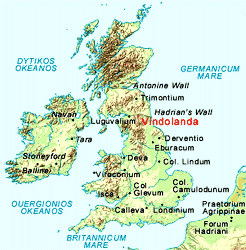
Click on the image for a larger version.
|
Image
details:
Vindolanda and the major settlements of Roman
Britain
Image ownership:
© Ancient World
Mapping Center.
|
Vindolanda lies in the middle of the neck of land where northern
England is at its narrowest between the North Sea and the Irish
Sea. High in the Pennine hills above the valley of the South Tyne,
it is c.25 miles (40 km) from Carlisle in the west and a few miles
more from Newcastle in the east. The site is a mile south of Hadrian's
Wall's most spectacular and best preserved section on the Whin Sill.
A garrison occupied the fort from the late first century AD to the
Roman army's abandonment of its northern British frontier over three
centuries later. The early garrisons had themselves been recruited
from the edge of the empire, from Gauls and Germans on the lower
Rhine. The exotic origins of some of the troops are indicated in
their un-Roman names, such as Gnavorix, Chrauttius and Gambax. Its
location, on the outermost edge of one of Rome's most remote provinces,
meant that Vindolanda was highly dependent on its own resources
and resourcefulness. The range of skills documented at the fort,
from brewing to plumbing, as well as careful husbanding of materials
- surviving remnants of footwear show that pieces of leather were
re-used several times over - demonstrate the extent of the fort's
self-sufficiency.
Yet the Vindolanda garrison was by no means utterly isolated. The
garrison was part of an army of c.50,000 men, distributed across
northern Britain. The roads, built to support the conquest of Britain,
ensured rapid communications with other garrisons and with the south
- London could be reached in less than a week- and with the Continent.
Concrete witnesses to the long-distance connections are tablewares
from Gaul and olive oil amphorae from Spain. One tablet may refer
to a trip to Rome itself (283). Fashions
in footwear at Vindolanda kept up closely with contemporary styles
across the empire.
Along the newly-built roads passed not only people and materials
but also information. Excavations at Vindolanda have revealed a
previously unknown type of document, wooden writing tablets written
in ink, easily and cheaply produced from local wood. On such writing
tablets could be sent the letters that conveyed greetings and maintained
connections. The prefect of the fort was in correspondence with
the circle of the governor of the province, sometimes a dinner guest
at Vindolanda. From Britain's governor, a powerful figure to whom
one of Rome's largest provincial armies was entrusted, it was only
one step to the ear of the emperor. Engaging in an elegantly expressed
correspondence was an important part of elite Roman savoir-faire.
Beyond the high-ranking officers and military clerks, ordinary soldiers
were also using letters to exchange news, request presents and send
thanks.
At Vindolanda a combination of factors have acted to preserve
this type of document, but they must have been in wide use and are
now being discovered at other sites, for example Carlisle and in
Wales at Caerleon.
|